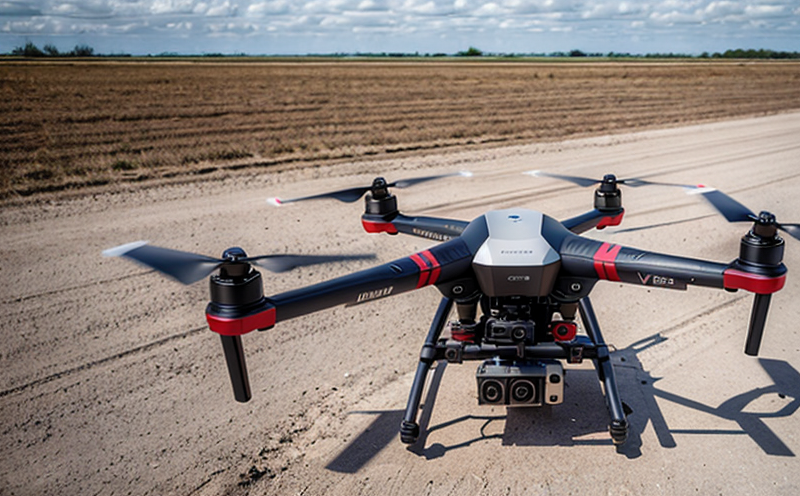RTCA DO-160 UAV Environmental Qualification Testing
The RTCA DO-160 standard is a cornerstone in aerospace and aviation testing, providing guidelines for the environmental qualification of aircraft and related systems. This standard ensures that equipment can withstand various environmental conditions without compromising performance or integrity. In recent years, the use of UAVs (Unmanned Aerial Vehicles) has grown exponentially across industries such as defense, agriculture, delivery services, and surveillance. The RTCA DO-160 UAV Environmental Qualification Testing is specifically tailored to ensure that these systems meet stringent environmental requirements.
UAVs operate in a wide array of environments, from arid desert conditions to tropical rainforests, and must perform reliably under extreme temperatures, humidity levels, and atmospheric pressures. The DO-160 standard provides comprehensive testing protocols for ensuring that UAV components are robust enough to endure these harsh conditions. This includes exposure to high altitudes with reduced oxygen levels, intense sunlight, sandstorms, and salt spray.
The testing process involves a series of environmental chambers designed to simulate the specific conditions under which the UAV will operate. These chambers can replicate temperatures ranging from -50°C to +60°C, humidity levels up to 100%, and atmospheric pressures as low as 29.5 inches Hg (equivalent to an altitude of about 34,000 feet). The testing procedure includes exposure times that are proportional to the expected operational time in each environment.
The DO-160 UAV Environmental Qualification Testing is not just a checklist of tests; it requires thorough planning and execution. Specimen preparation involves ensuring that all components are representative of real-world conditions, which can include cleaning, coating, or encapsulating certain parts to enhance their durability. The testing apparatus used includes specialized chambers capable of simulating the exact environmental parameters required for qualification.
After exposure to these conditions, the UAV undergoes a series of functional and performance checks to ensure that it meets all specified criteria. This might include checking battery life under extreme temperature variations, observing camera resolution in high humidity environments, or verifying structural integrity after exposure to sandstorms. The testing process is rigorous and detailed, ensuring that every aspect of the UAV's design withstands the rigors of its operational environment.
The results of this testing are critical for compliance with regulatory bodies such as the Federal Aviation Administration (FAA) in the United States and similar organizations worldwide. Compliance not only ensures safe operation but also enhances the reputation of the manufacturer by demonstrating a commitment to quality and reliability. The detailed reports generated from these tests provide valuable insights into any potential weaknesses or areas requiring improvement.
Applied Standards
The RTCA DO-160 standard is widely recognized in the aerospace industry for its comprehensive approach to environmental qualification testing. The current version, DO-160G, provides a structured framework that covers various aspects of UAV environmental qualification testing:
- DO-160A: General requirements and procedures.
- DO-160C: Environmental conditions for airworthiness.
- DO-160D: Environmental test methods, including temperature cycling, altitude pressure, humidity, and more.
The standard is regularly updated to incorporate the latest technological advancements and regulatory changes. Compliance with these standards ensures that UAV systems are not only robust but also meet international safety and performance criteria.
Why Choose This Test
Selecting RTCA DO-160 UAV Environmental Qualification Testing is essential for several reasons. First, it ensures that your UAV meets the strictest environmental standards set by regulatory bodies and industry experts. This not only enhances safety but also builds trust with end-users and stakeholders.
Second, this testing process provides valuable data on how well your UAV can perform under various conditions. This information is crucial for improving design and manufacturing processes, leading to more reliable products. Additionally, it helps in identifying potential areas of improvement that could enhance the overall performance of the UAV.
Third, compliance with DO-160 standards enhances marketability. Consumers and industries are increasingly demanding UAVs that can operate reliably under extreme conditions. By meeting these environmental qualification tests, you demonstrate your commitment to quality, which can significantly boost sales and brand reputation.
Forth, this testing process helps in identifying any potential issues early on, reducing the risk of costly repairs or recalls later. Early detection allows for timely corrections, saving time and resources while ensuring that products meet all necessary standards before launch.
Quality and Reliability Assurance
The RTCA DO-160 UAV Environmental Qualification Testing is a critical component of quality assurance programs. By subjecting your UAV to this rigorous testing, you ensure that it meets the highest standards of reliability and performance.
Firstly, environmental qualification testing helps in identifying any design flaws or material weaknesses early in the development process. This proactive approach allows for necessary modifications before production begins, saving time and costs associated with post-production changes.
Secondly, it provides a robust foundation for ongoing quality control measures. By establishing baseline performance data through these tests, you can set benchmarks against which future products can be measured. This continuous improvement process ensures that each new model of UAV is even more reliable and capable than its predecessors.
Thirdly, compliance with RTCA DO-160 standards also contributes to regulatory approval processes. Many countries have strict regulations governing the use of UAVs in public airspace, and meeting these environmental qualification requirements is often a prerequisite for obtaining necessary permits or certifications.
Finally, the credibility provided by successful completion of this testing process can greatly enhance your company's reputation within the industry. Demonstrating a commitment to quality through rigorous testing not only builds trust with customers but also differentiates your products in competitive markets.





